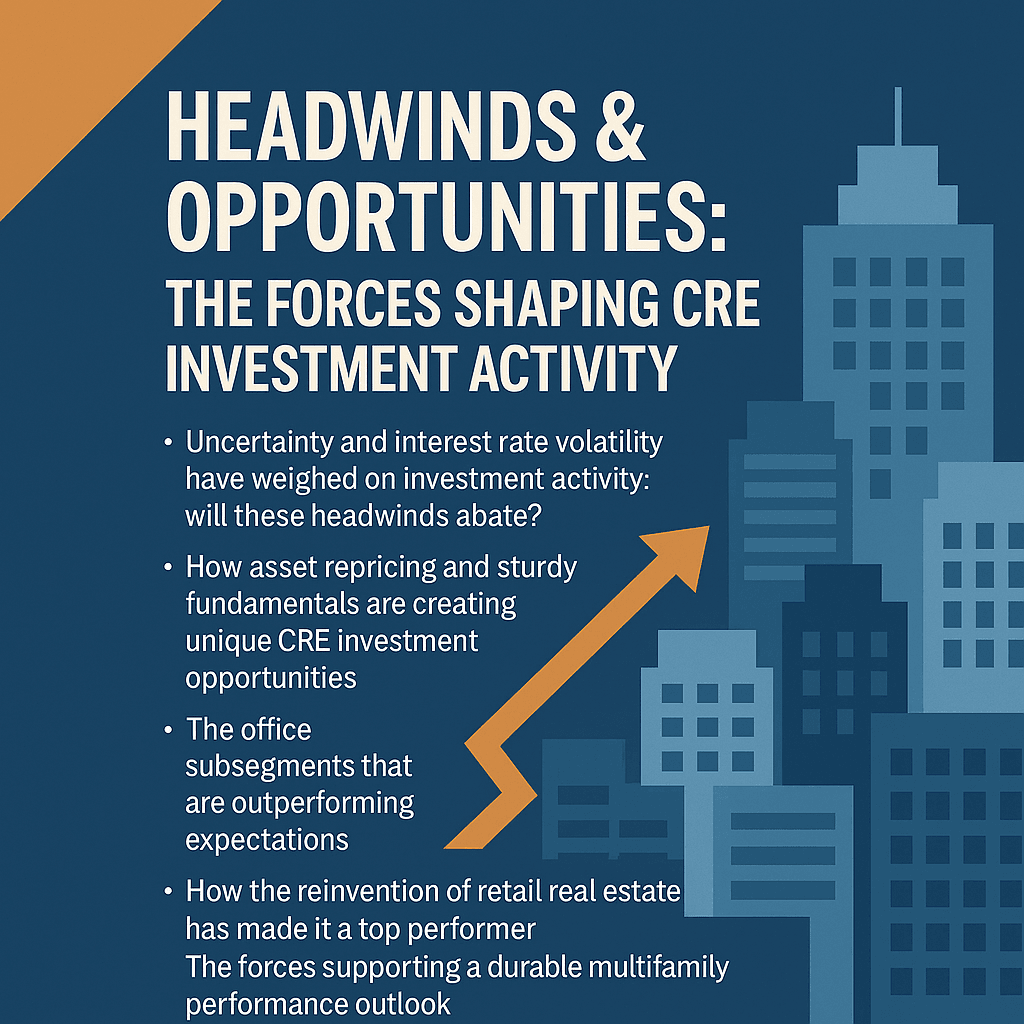https://www.creconsult.net/partners/

eXp Commercial is one of the fastest-growing national commercial real estate brokerage firms. The Chicago Multifamily Brokerage Division focuses on listing and selling multifamily properties throughout the Chicago Area and Suburbs.


The Commercial Real Estate Symposium will provide junior and senior agents and brokers with valuable insights on topics, including: international opportunities, capital and funding for small businesses in today’s market, how to attract investors, and much more.
Dates: April 25-26, 2023
Start Time: 9 a.m. - 4 p.m. CST
Location: eXp Commercial Campus
We look forward to seeing you in the metaverse!
Important: Please download the virtual eXp Commercial Campus prior to the event, and follow the instructions to login and create your avatar. Feel free to explore the campus before the event begins.

Finding your next multifamily investment can be challenging, especially in today’s market environment. Cap rates are at record lows, and interest rates are rising. Inflation climbed 7.9% year-over-year as of February 2022, increasing operating expenses and the cost of capital improvements. Rent growth has been the only saving grace, surging nearly 20% across the top 50 metros in 2021.
Discovering the right opportunity requires looking at more deals when they hit the market and being prepared to move forward quickly with a firm bid. Understanding your financing options is vital for improving your chances of being awarded a deal and maximizing your returns.
When considering your financing options for 5+ unit multifamily properties, you should go beyond your local bank and consider financing through an agency small loan program. Fannie Mae Small Loans and Freddie Mac Small Balance Loans (SBL) offer some of the most competitive terms in the market, so they’re worth exploring if your property is eligible. This article will walk you through your financing options and help you navigate the property-specific agency small loan requirements, so you know what to look for when searching for your next multifamily investment.
Fannie Mae Small Loans and Freddie Mac Small Balance Loans (SBL) can be game changers for achieving your investment goals, limiting risk, and maximizing returns. They typically provide an ideal mix of low rates, maximum leverage, speed to close, and non-recourse debt for stabilized, 5+ unit multifamily properties. Specific benefits include:
| Financing options | Potential advantages | Typical disadvantages |
| Banks and credit unions | Floating rate options Less than 5-year loan terms available Shorter closing time frame Less stringent property and borrower requirements Lower prepayment penalties Less due diligence/ documentation Lower closing costs |
Higher rates Capped at 75% LTV Limit cash-out proceeds 25-year amortization 5–10-year maximum loan terms Limited interest-only Full or partial recourse Not assumable Limited geographically Deposit requirements Less stable source of capital |
| FHA/HUD | Lower rates Up to 35-year amortization and loan terms Construction and rehab loan products are also available |
Typically require 6+ months to close More excellent due diligence/ documentation No hybrid rate options |
| CMBS | Less stringent property and borrower requirements May allow the use of mezzanine debt or preferred equity |
Higher rates Capped at 75% LTV 10-year maximum loan term $2MM minimum loan amount Less flexible prepayment options Cannot hold rate until a few days before closing Less stable source of capital More stringent servicing requirements w/ cash management triggers |
| Life companies | Lower rates Rate locked at the application |
Capped at 65-70% LTV Limit cash-out proceeds Limited to higher-class properties 25-year amortization $2MM minimum loan amount |
| Debt funds, construction, bridge, and hard money lenders |
6-month to 3-year loan terms Do not require stabilized Occupancy (lend on new construction, lease-up, and rehabilitation/ redevelopment projects) Shortest closing time frame |
Higher rates and only floating rate options are available Capped at 75% LTV Shorter loan terms Partial or full recourse |
Local banks and credit unions may provide greater flexibility and lower closing costs, however; they will likely have higher rates and limit you to 75% LTV, 5-year loan terms, 25-year amortization, no interest-only, and require at least partial recourse.
Lenders that may be able to offer lower rates, such as FHA/HUD or life companies, require greater due diligence and can take too long to close (FHA/HUD) or are only available for higher class properties and limit your loan proceeds to less than 70% LTV (life companies).
So, what should you look for when searching for your next multifamily investment to ensure you can take advantage of the ideal mix of terms provided by Fannie Mae and Freddie Mac’s small loan programs?
A great place to start your property search is right here on Crexi! You can apply the following filters to make sure your property meets the agency programs’ “must-have” requirements:
And don’t forget to consider the other eligibility criteria as you narrow your search. Once you’ve identified a winning property and are ready for more precise loan terms based on your unique situation and goals, connect with one of our expert MultiFi partners to learn more and get a quote!
Source: How to Find and Finance Your Next Multifamily Property | Crexi Insights
https://www.creconsult.net/market-trends/how-to-find-and-finance-your-next-multifamily-property/ [ux_text text_align="left"]
[ux_text text_align="left"]
Top Frequently Asked Questions on Selling a Multi-family in Chicago
Here are some of the most frequently asked questions we get from clients looking to sell multifamily properties in Chicago.
If you’ve sold an investment property before, you’ll be familiar with the ins and outs of selling a multi-family. However, if it’s your first time, you’ll learn that the process works differently than it would with a single-family or condo.
A large part of a multi-family’s sale appeal will lie in its cash flow. Buyers looking for a multi-family are looking for more than just a home: they will want to see a property that generates good rental income, rents easily, and provides a financial incentive for them to buy. This could be in the form of easy upgrades they can make to boost rental income or as an empty unit for them to occupy and offset their own living expenses.
Of course, we’re biased...but we do recommend working with a broker who is experienced in the multi-family market in your neighborhood. Not only will they be able to pull good comps and provide a market analysis of how you should price the property, but an experienced agent will know how to show the proeprty to different types of buyers, whether they are experienced investors or first-time multi-family buyers who want some supplemental income. Brokers who work in multi-family markets are also in the know about rent prices and trends, which will help them sell your home at the right price.
Some buyers look for multi-families with units that could benefit from some updating because they see it as an opportunity to raise the rent using some sweat equity. Your agent should be knowledgeable of the renter’s and buyer’s market for your area and property type and will have good recommendations of what types of updates to make before selling.
Making simple upgrades around the property and in common areas like hallways and entryways can be an easy way to boost the property’s curb appeal that won’t break the bank, whether it’s through new fixtures or a fresh coat of paint.
One of the most important parts of getting ready to list your property is confirming the number of legal units in the building. In a city full of old homes like Chicago, many apartment units have been created in old basement spaces or have been de-converted into larger single unit. If you sell your property with an incorrect number of legally recognized units, you could face legal issues down the road. To get the most accurate picture of how your property should be valued and listed, get in touch with the local village to confirm the number of legal units listed in their records.
Buyers and their lenders will typically appraise a multi-family home using the income approach method instead of simply using comps in the area to compare values. This means that the appraiser will look at the cost of property maintenance and rental income to evaluate a property’s cash flow. To price your multi-family, you should do appraise a building’s income and use comps in the area to accurately represent what someone might want to pay for it.
One of the trickiest parts of selling a multi-family is to make sure that you are aware of your tenants’ legal rights and that you make the selling process as effortless for them as possible.
An experienced Broker will know the ins and outs of how to show a property with occupied units (which is one of the biggest reasons why you should take your time to find a good agent). The most important concern when it comes to showing units is to make sure that the tenant is aware of the appointment sufficiently ahead of time. Check your lease agreement to see if there are already guidelines in place, or contact your tenant prior to listing the process to come to an agreed-upon amount of days or hours before the showing when they should be contacted.
Source: Selling an Apartment Building FAQ’s
[/ux_text] https://www.creconsult.net/market-trends/selling-an-apartment-building-faqs/
Diversifying your investments is always a good idea. And in an economic moment like the present, it's a borderline necessity when the market looks to be approaching a volatile period.
For investors in residential real estate looking to upgrade their portfolios while scaling down their risk, commercial real estate offers an exceptionally safe and lucrative harbor. The commercial real estate market is much more insulated from market shocks than the residential market. The returns can be very attractive — often on par with top-quality investments like dividend stocks.
Let’s look at some of the unique pros and cons of investing in commercial real estate and some of the best ways to allocate your money in the commercial real estate world.
Commercial real estate investing is different from residential real estate investing in some fundamental ways. First of all, there’s more money involved. The average commercial property has a higher price tag than all but the highest-end residential properties, so it’s tougher to buy in.
Those high stakes also necessitate more careful analysis. While a simple comparative market analysis is great for residential investments, a commercial real estate investment demands more in-depth number-crunching.
However, that high price tag has an upside. Commercial investments are based more on careful analysis rather than heated speculation. Since relatively few investors can participate, there’s much less competition in the market.
Commercial properties also come with long, multi-year leases, ensuring a steady cash flow. Returns on a typical commercial investment are 6% to 12%, much higher than the standard residential return.
Finally, commercial properties can be extraordinarily low-maintenance. While residential rentals can be pretty low-maintenance if you work with a property management service, property managers also eat up a significant percentage of your rents. Using a triple net lease for your commercial property means the tenant pays maintenance, taxes, utilities, insurance, and everything but the mortgage. While triple net leases come with slightly lower rents than leases in which the owner foots some of these costs, they’re still much more lucrative, on a dollar-for-dollar basis, than professionally managed residential properties.
So what are the best ways to diversify into commercial real estate? Let’s look at some of the most popular paths.
If you want the most streamlined, low-maintenance commercial real estate experience, putting your money into a project led by a transaction sponsor is likely the best way.
A transaction sponsor scouts out potential commercial projects. When they find one that’s promising, they negotiate a purchase agreement, assemble investor materials, and bring in the capital needed to buy or renovate the property.
You don't have to do much as an equity investor in a project like this. The transaction sponsor will oversee and is responsible for every phase of the project, from pre-acquisition due diligence through to the final disposition of the finished product.
To maximize diversification, allocate money to several different transaction sponsors. Since most sponsors specialize in various projects, you’ll likely have money in various properties.
There are four main types of commercial real estate; allocating your money among them can further insulate you from risk. The main types are:
This type includes buildings like warehouses as well as production or logistics facilities. Industrial properties offer excellent cash flow and low operational risks but are vulnerable to market downturns. They’re also typically quite large, which translates to high upfront costs.
Office spaces offer excellent stability for investors, as leases are typically long and come with low tenant turnover. However, one of the significant downsides of a long lease is the few opportunities for rent increases. On top of that, there may be high upfront costs if an office space needs to be customized for a specialized client, like a medical facility.
While office spaces are typically stable even in volatile economic times, the rise of remote work during the pandemic has cast the future of office space into doubt.
Tenants like retail shops, gyms, entertainment properties, and bank branches use these properties. Similar to office space, retail spaces often come with long leases. On the downside, retail tenants are vulnerable to market changes and sometimes go bankrupt. Because the spaces are highly customized, expensive renovations are often necessary between tenants.
A commercial multifamily property has five or more residential units. While these properties are well insulated from economic turbulence, they come with the labor-intensive obligations of smaller residential investments — for example, property management costs and high tenant turnover. Despite their residential nature, these properties are still considered one of the core types of commercial real estate.
The genius of diversifying among different commercial real estate types is that you can take advantage of every market condition. For example, in a booming economy, you’ll reap the benefits of owning industrial space, and when the market enters a downturn, your multifamily investments will weather the storm.
Savvy investors can also allocate their money to and invest in real estate along different commercial properties. Commercial property classes are:
This is the highest quality commercial property. Typically, the property is new, well-maintained, and centrally located. Consequently, it offers shallow risk and very predictable returns.
The second-highest commercial property class is usually between 10 and 20 years old, in need of minor renovations, and in a decent but not top-quality market. This property class offers slightly more risk but can give investors great returns if correctly managed.
Older properties (usually between 20 and 30 years old) require moderate repairs. Nearing the end of their usable life, they’re also located in fringe areas and require prudent management to deliver a consistent return.
These obsolete properties may require significant renovations or repairs to get back to acceptable conditions. Their very low buy-in could yield considerable profits to an innovative manager, but they could also result in a total loss.
Again, allocating investments among every class can offset risk and maximize profit. A Class A investment will consistently bring in cash flow, while a handful of lower-class assets can result in exponential gains.
Finally, allocating money among different geographical locations allows you to avoid being too tied up in the fortunes of any one market. Especially as issues like climate change threaten prime coastal markets like Miami and water scarcity threatens prospects in the West and the Sun Belt, it’s essential to keep “location, location, location” in mind.
Commercial real estate investments offer a viable and reliable sector into which to invest capital and diversify your portfolio. It’s worth exploring various asset classes, locations, and property types to find the best investment property. And, of course, when in doubt, it’s best to talk to an experienced commercial real estate broker to gain detailed market knowledge before you buy and receive guidance throughout the investment process.
Source: How to Diversify Your Investments With Commercial Real Estate | Crexi Insights
https://www.creconsult.net/market-trends/how-to-diversify-your-investments-with-commercial-real-estate/
As rising interest rates and economic volatility have stifled buying power for investors over the last six months, commercial real estate sellers often have found themselves somewhat of a standoff with potential purchasers.
Who will make the first move in adjusting expectations?
For the brokers sitting in on those negotiations daily, it comes down to serving both sides a dose of reality about market conditions. And that isn't accessible medicine for buyers or sellers to swallow right now.
"The reality is, sellers still want 2021 pricing, but buyers just can't step up to that number," Joe Powers, regional manager of Marcus & Millichap's Chicago downtown office, told Bisnow.
The bid-ask spread between the highest price a buyer is willing to pay and the lowest price a seller is willing to accept proved to be a challenge in 2022 and continues to be one into 2023.
"It's become more important now, I think, than in recent years because, for a while there, you could throw a number out there, and someone would grab it, whereas now, real information is dictating the market," Powers said.
In office space especially, the bid-ask divide has become particularly wide, reaching a spread of about 30%-40% as of November and December 2022, according to Wei Luo, global associate research director at CBRE Investment Management. Before the pandemic, the bid-ask spread hovered around 10%-20% for offices.
"It's common for a spread between the bid and asks. That's why we need brokers," Luo told Bisnow. "It's not uncommon, but I would say once the gap reaches beyond 30%, that's when the sector has a problem. That's when activity will be coming to a standstill. ... When people go to a negotiation, they're not expecting to cut 20% off their price."
In its 2023 Trends to Watch in Real Assets report, MSCI estimated that London office prices would need to fall 29.3% from October 2022 levels, and New York offices would need to drop 10.4% to bridge the gap between what sellers want and buyers are willing to pay, Bisnow reported.
Meanwhile, CBRE predicts another 5%-7% decrease in investment values in 2023, coming off a 10%-15% decline across the first three quarters of 2022.
"As the market has become more difficult the last four to six months, people have struggled with, from a sell side, how tough do I become, and from a buy side, how much am I willing to move up?" Steven Weinstock, regional manager of Marcus & Millichap's Oak Brook office, told Bisnow. "The sellers have been unwilling to move because 'I still own the real estate, so why am I going to make the first move? Nothing is causing me to make the first move.'"
In the case of office buildings, the spread is starkest when it comes to the differences between modern Class-A buildings and older buildings.
"When more modernized offices have become available, I think that's when you start to see that spread because investors now realize the bifurcation has begun, so you have two different assets — one that's kind of future-proof, one that's going to be obsolete at some time in the future," Luo said.
Office buildings that might have been built in the 1980s or '90s and weren't well maintained are bearing the brunt of the hit to their values, mainly as the pandemic brought into question the future of the office, Luo said.
However, new developments built with environmental, social, and governance principles in mind and modern amenities have seen demand outpace supply even in a downturn as investors participate in a flight to quality, she added.
"For any owners that are trying to sell right now, their goal is to get liquidity," Luo said. "They want to sell the office asset they own to get capital, to get cash so that they can recycle the capital into better-performing assets. But for the buyer who's in the market trying to buy an office, they want to buy low and sell high. They're looking for discounts when the owners are looking for capital."
Because both sides have misaligned goals and differing price expectations, Luo said, "it's tough to bridge when you're in such a tightened credit condition."
Luo said that retail, industrial and residential properties face price adjustments based on higher borrowing costs, but the bid-ask gap is relatively small compared to the office.
If interest rates stabilize, that will help close the gap, but office owners, in particular, will need to take some write-downs, which she said they have already started doing,
"Many office investors in the industry have started to do that because that's the reality. We can't bury our heads in the sand," Luo said.
Widening the pool of potential buyers has helped sellers become more realistic and get a sense of fair market value for their assets.
"The bid-ask gap has become a 'who's going to blink first?'" Weinstock said. "Sellers have started blinking. They started saying, 'I got enough offers. I have enough interest. I know what the market pricing is. Even though I wanted more, if I want to transact, I've got to take the market price.'"
"It works if you take a property and bring it to market, expose it to the most people, and create competition," Weinstock said.
"In 2001, money didn't go across state lines. You stayed local," Weinstock said. "In 2023, you're not concerned where the property is anymore, so it's become very robust."
"There are two reasons why a property doesn't sell. It's either exposure or pricing, and if we've been able to generate multiple offers from qualified buyers, the market has spoken, and it's a function of pricing."
During this time of economic turbulence, WHe said Weinstock encourages sellers to sit down with their financial advisers to discuss their options, which aren't just to sell or own anymore; they can also decide to hang onto their assets and make improvements or to refinance and use the additional capital for other investments.
Industry players told Bisnow they see the gap narrowing by year's end.
"We always come out of it, and statistically, mathematically, the succeeding 12 months after whatever economic uncertainty there is have always produced a significant gain for the commercial real estate market," Weinstock said. "All we have to do is help our clients during this turmoil, however long or short."

Tenancy in common (TIC) is a real estate transaction in which there is more than one owner of a specific property. It is not an uncommon situation, but it can have both good and bad factors related to it. Understanding tenancy in common in a commercial real estate transaction is a critical step if this type of structure will be used.
TIC is a type of ownership structure. In this transaction, more than one party will own the same property. There are some situations where this can be good, for example, because it can make it simpler for borrowers to get the financing they need for a property. However, TIC can also come with several legal and sometimes more complex complications when the owners do not have good practices.
There are various situations when this could occur. For example, it can be set up through paperwork by two or more parties as co-owners during the purchasing process of commercial real estate. It could also be a default situation under the state's property laws. Sometimes it is necessary because one person or organization can't hold the property alone.
This legal arrangement occurs when two parties (or more) share commercial real estate ownership rights. In this arrangement, the owners may share privileges and interests in all aspects of the property. While they share those interests, they can have different levels of rights or percentages of their overall interest in the property.
This type of agreement is flexible in that it can be created anytime. It is possible to add a new tenant in common at any time during the ownership, even after other parties have entered the agreement.
Answer a few questions and get custom mortgage quotes. We'll match you with offers from our network of 650+ lenders.
What is the difference between joint tenancy and tenancy in ordinary?
It is not uncommon for a property that more than one individual owns to be a joint tenancy rather than a common one. When it is a joint, the structure must conform to a specific set of rules or standards. These are often called TTIP. These standards require that each joint tenant must start their ownership of the property together.
In addition, it must be documented on the property's deed – the same deed. In addition, each joint tenant has to have the same type of ownership share in commercial real estate. That includes providing equal possession rights to the property. In many situations, a joint tenancy becomes a TIC when one tenant decides to sell their portion of the property's ownership to another joint tenant or party.
This is very different from what can be expected in a TIC situation. For example, it is not uncommon for each tenant to have a different percentage of ownership shares in the property. In some cases, one party may have a 30 percent stake of ownership and the other 70 percent, or any further configuration. Unlike joint tenancy, all parties must have the same privilege level.
Another difference is that the ownership of the property does not have to occur at the same time as it does in joint tenancy. Instead, adding a new tenant at any time is possible, which is not uncommon.
Another significant difference is that when a commercial real estate investor dies in a TIC, the property's share does not automatically go to the other property owners. That's what occurs in a traditional joint tenancy. In a TIC, though, the property owner can pass to the named heir of the tenant.
When considering tenancy in common in a commercial real estate transaction, it is critical to know the pros and cons of this scenario. Considering living in its ordinary meaning, consider the following.
There are numerous benefits to this arrangement.
For example, it allows for the property to be purchased. In other words, all aspects of the purchase are more accessible, allowing all parties to participate. This includes dividing up the down payment, maintenance, upgrades, and payments.
In addition to this, in comparison to a joint tenancy, a TIC can allow the tenant structure to change over time, meaning that more people can be added to it. Also, different degrees of ownership are permitted, providing more flexibility than a joint tenancy.
There are some disadvantages of tenancy in common also to consider.
For example, when a mortgage is obtained to purchase commercial real estate, all borrowers agree to the terms and conditions of the loan together. When this happens, all parties hold equal liability to the property.
For example, if one of the tenants in common does not make payments as agreed, the other parties could be held responsible or have assets seized. There are also no automatic survivorship rights in a TIC, which could be concerning for some property owners. Other factors to remember include that any tenant can cause the forced sale of the real estate property at any time.
With the TIC structure, there are some factors to consider when it comes to taxation. Most of the time, the TIC receives a single tax bill. This bill is then divided based on the amount of commercial real estate each party owns. This requirement is often outlined in the agreement that all parties agree to.
There could be some local and state laws that play a role in this, but the tenants make their own decision about how this payment is structured.
It is also important to note that each TIC will have a liability in the tax bill. For example, if one of the parties defaults on their payment because they filed for bankruptcy, the other tenants must pay that bill.
In some situations, it may be necessary to dissolve the tenancy in common. One member of the TIC can buy out the other members. This would lead to the dissolving of the TIC. It is done in a joint agreement.
Sometimes the parties cannot agree on the dissolving of the property. This may lead to a breaking up of the ownership in a court order and legal proceeding.
In many situations, the use of TIC is sensible and beneficial, creating an opportunity for property owners to achieve the purchase and ownership of commercial real estate property in a meaningful manner. When considering this type of structure, investors must consider the drawbacks, including the shared liability in tax and mortgage liens and the process for dissolving them. Without a doubt, TIC is not uncommon and is readily used in various scenarios as a viable solution for ownership.
Source: What is Tenancy in Common in Commercial Real Estate?
https://www.creconsult.net/market-trends/what-is-tenancy-in-common-in-commercial-real-estate/Introduction In 2025, the real estate world looks different. Warehouses are booming, retail is rebounding, and suburban office spaces are ou...
